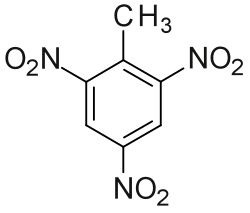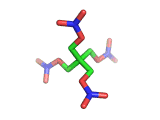We're starting the first post of the year with a bang!
More specifically, we're gonna discuss what makes the bang: explosive molecules such as the well-known TNT (Trinitrotoluene).
(Structure of a TNT molecule)
(Structures of a) methenamine and other explosive compounds; b) RDX; c) HMX; d) HMTD; e) PETN)
(A 3-D representation of a PETN molecule)
First, as we mentioned above, these are all explosive molecules! All of these materials have at one point been used in warfare, due to their ability to explode readily.
In fact, PETN was used in the recent and infamous incident of the Underwear Bombing in 2009! The terrorist, Umar Farouk Abdulmutallab, was found with 80 grams of PETN sewn into his underwear.
(The device used in the bombing attempt of 2009. The PETN molecules can be seen in the center.)
But hold on! All of the molecules shown above are remarkably symmetric!! Aren't symmetric molecules supposed to be stable by themselves? Why would they want to explode? And especially why spontaneously?
Well first of all, stability is not the only factor in predicting whether a molecule spontaneously goes into reaction. In fact, that's determined by what's called the Gibbs free energy, notated with the letter G. It basically refers to the amount of energy that can be used to do work, and the equation for this energy is described below:
The ΔH represents enthalpy, the T represents temperature, and the ΔS represents entropy.
In general,
if ΔG is negative, the reaction is endergonic, which implies that
it is also spontaneous! That's what determines it.
In the case of explosives, we see two things:
1) All of the explosive molecules mentioned before are exothermic, meaning that they
have negative changes in enthalpy.
2) All of them also have positive values of entropy!
The specific values of enthalpy and entropy for TNT and PETN can be seen below (click on the image to see a bigger picture):
And because of these values, ΔG is VERY negative! This reveals exactly why these symmetric molecules explode so viciously and spontaneously.
But wait-- shouldn't aren't symmetric molecules very "ordered"? They don't look disordered, but why are their entropies so high?
Sadly, if you were thinking that, you've fallen into a trap. If anything, entropy measures how complicated (in a sense) a system is. In this case, we see that these molecules are all actually very complicated, especially compared to their decomposition into fairly simple gases!
For example, PETN starts one of its forms of decomposition in the following way:
(This process, in which nitrogen dioxide is separated, happens rapidly throughout its decomposition.)
Its ultimate forms of decomposition can be seen below:
We can see that eventually, the entire, complicated molecule turns into mere carbon dioxide, carbon monoxide, water, hydrogen gas, nitrogen gas, and other basic molecules!
Lastly, what's even more shocking is that these symmetric molecules aren't even as stable as we thought! Although they are perfectly symmetric, they are actually restricted in movement! Thus, when they are triggered, they rearrange themselves rapidly, releasing these more stable products.
All of this shows exactly why and how explosives create the BANG that we know of.
(Explosion caused by TNT)
What a shocking turn of events-- who knew symmetry wasn't always the desired form of molecules?









No comments:
Post a Comment